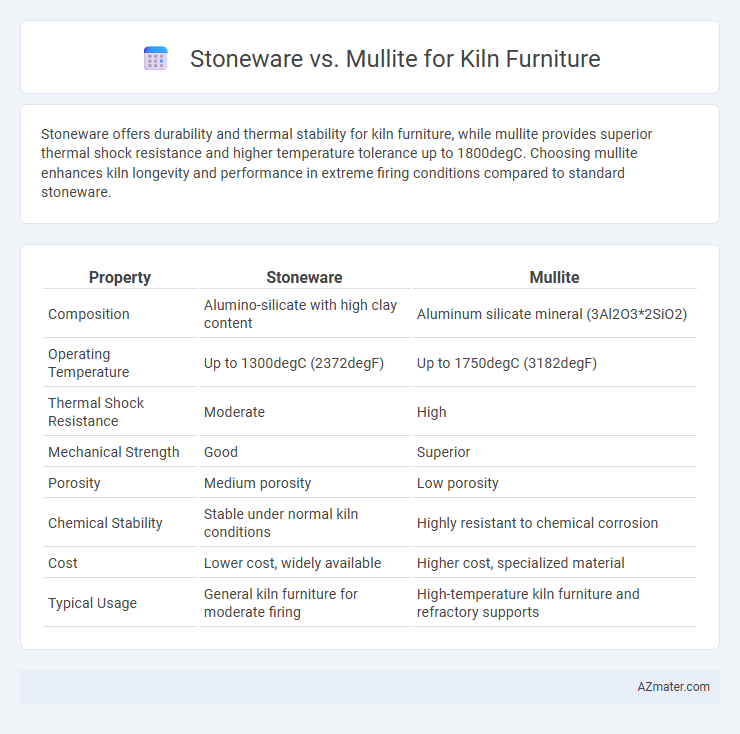Stoneware offers durability and thermal stability for kiln furniture, while mullite provides superior thermal shock resistance and higher temperature tolerance up to 1800degC. Choosing mullite enhances kiln longevity and performance in extreme firing conditions compared to standard stoneware.
Table of Comparison
| Property | Stoneware | Mullite |
|---|---|---|
| Composition | Alumino-silicate with high clay content | Aluminum silicate mineral (3Al2O3*2SiO2) |
| Operating Temperature | Up to 1300degC (2372degF) | Up to 1750degC (3182degF) |
| Thermal Shock Resistance | Moderate | High |
| Mechanical Strength | Good | Superior |
| Porosity | Medium porosity | Low porosity |
| Chemical Stability | Stable under normal kiln conditions | Highly resistant to chemical corrosion |
| Cost | Lower cost, widely available | Higher cost, specialized material |
| Typical Usage | General kiln furniture for moderate firing | High-temperature kiln furniture and refractory supports |
Introduction to Kiln Furniture Materials
Stoneware and mullite are two primary materials used in kiln furniture, essential for supporting ceramics during firing. Stoneware offers excellent thermal shock resistance and affordability, while mullite provides superior high-temperature strength and minimal thermal expansion up to 1750degC. Choosing between stoneware and mullite depends on the firing temperature, load requirements, and durability needed for specific ceramic processes.
What is Stoneware?
Stoneware is a type of dense, durable ceramic material fired at high temperatures, typically between 1,200degC and 1,300degC, making it ideal for kiln furniture that must withstand extreme heat and mechanical stress. It is composed primarily of clay and other natural materials, resulting in low porosity and high resistance to thermal shock and chemical corrosion. Compared to mullite, stoneware offers cost-effective durability but generally has lower thermal stability and strength for extremely high-temperature applications.
What is Mullite?
Mullite is a high-temperature ceramic material primarily composed of alumina and silica, known for its exceptional thermal stability and mechanical strength in kiln furniture applications. It resists thermal shock and maintains structural integrity at temperatures exceeding 1750degC, making it superior to traditional stoneware in high-heat firing processes. Mullite's unique crystalline structure minimizes shrinkage and deformation, enhancing the durability and lifespan of kiln shelves and supports.
Key Properties of Stoneware
Stoneware kiln furniture offers high thermal stability, remarkable mechanical strength, and excellent resistance to thermal shock, making it suitable for prolonged use in high-temperature environments up to 1300degC. Its dense, vitrified structure provides low porosity, reducing gas permeability and contamination risks during firing processes. Stoneware's robust durability and cost-effectiveness make it a preferred choice for kiln supports in ceramics manufacturing compared to mullite, which excels primarily at higher temperature thresholds.
Key Properties of Mullite
Mullite offers superior thermal stability and mechanical strength compared to stoneware, making it ideal for kiln furniture exposed to high temperatures above 1500degC. Its low thermal expansion prevents cracking and deformation, ensuring durability during thermal cycling in ceramic firing processes. Additionally, mullite's excellent resistance to chemical corrosion enhances kiln furniture lifespan in harsh kiln atmospheres.
Thermal Performance Comparison
Stoneware kiln furniture offers reliable thermal resistance up to about 1300degC, making it suitable for moderate firing temperatures with good durability. Mullite provides superior thermal performance withstanding temperatures exceeding 1700degC and exhibits excellent thermal shock resistance, reducing breakage during rapid temperature changes. The enhanced mechanical strength and higher melting point of mullite make it ideal for high-temperature kiln applications requiring prolonged heat exposure.
Mechanical Strength and Durability
Stoneware kiln furniture offers moderate mechanical strength and durability, ideal for general pottery firing but susceptible to wear in high-temperature environments. Mullite kiln furniture exhibits superior mechanical strength and exceptional thermal shock resistance, enabling longer service life and reliability during repeated firings at temperatures above 1300degC. The high alumina content in mullite provides enhanced structural integrity, making it the preferred choice for industrial kiln applications requiring maximum durability.
Cost and Availability
Stoneware kiln furniture typically offers a lower cost and wider availability due to its abundant raw materials and mass production, making it an economical choice for many ceramic applications. Mullite kiln furniture, while more expensive, provides superior thermal stability and durability in high-temperature firings, but its specialized manufacturing limits availability and increases overall expense. The decision between stoneware and mullite hinges on balancing budget constraints with the specific performance requirements of the kiln environment.
Best Applications for Stoneware vs Mullite
Stoneware kiln furniture excels in applications requiring high thermal mass and durability at moderate firing temperatures up to 1300degC, ideal for long soaking periods and heavy ceramic pieces. Mullite kiln furniture offers superior thermal shock resistance and stability at high temperatures above 1400degC, making it optimal for fast firing cycles and refractory applications in advanced ceramics and porcelain production. Selecting stoneware is best for durability and cost-effectiveness in traditional firing, while mullite suits high-temperature industrial processes demanding minimal deformation and maximum lifespan.
Choosing the Right Kiln Furniture Material
Stoneware kiln furniture offers excellent durability and moderate thermal shock resistance, making it suitable for general ceramics firing. Mullite, with its superior high-temperature strength and low thermal expansion, is preferred for advanced firing processes requiring exceptional thermal stability and longevity. Selecting between stoneware and mullite hinges on firing temperature, thermal shock demands, and cost-efficiency considerations in kiln operations.

Infographic: Stoneware vs Mullite for Kiln Furniture
 azmater.com
azmater.com